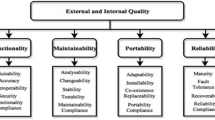Abstract
Most existing studies on software release policies use models based on the non-homogeneous Poisson process. In this paper, we discuss a software release policy based on a state space model. The state space model has a Gamma-Gamma type invariant conditional distribution. A cost model that removes errors in software systems and risk cost due to software failure is used. The optimal release time to minimize the expected cost in every test-debugging stage is discussed.
Similar content being viewed by others
References
Chang, Y. C. and Leu, L.Y. (1998). A state space model for software reliability,Annals of the Institute of Statistical Mathematics,50, 789–799.
Chen, Y. and Singpurwalla, N. D. (1994). A non-Gaussian Kalman filter model for tracking software reliability,Statistica Sinica,4, 535–548.
Chen, Y. and Singpurwalla, N. D. (1997). Unification of software reliability models by self-exciting point processes,Advances in Applied Probability,29, 337–352.
Dalal, S. R. and Mallows, C. L. (1988). When should one stop testing software?Journal of the American Statistical Association,83, 872–879.
Dalal, S. R. and Mallows, C. L. (1990). Some graphical aids for deciding when to stop testing software,IEEE Journal on Selected Areas in Communications,8, 167–175.
Johnson, N. and Kotz, S. (1970).Continuous Univariate Distributions-2, Houghton Mifflin Company, New York.
Kimura, M., Toyota, T. and Yamada, S. (1999). Economic analysis of software release problems with warranty cost and reliability requirement,Reliability Engineering and System Safety,66, 49–55.
Musa, J. D. (1979).Software Reliability Data, IEEE Computer Society Repository, New York.
Okumoto, K. and Goel, A. L. (1980). Optimum release time for software systems based on reliability and cost criteria,Journal of Systems and Software,1, 315–318.
Pham, H. (2000).Software Reliability, Springer, Singapore.
Randolph, P. and Sahinoglu, M. (1995). A stopping rule for a compound Poisson random variable,Applied Stochastic Models and Data Analysis,11, 135–143.
Ross, S. M. (1985). Software reliability: The stopping rule problem,IEEE Transactions on Software Engineering,SE-11, 1472–1476.
Runggaldier, W. J. (1993). Concepts of optimality in stochastic control,Reliability and Decision Making (eds. R. E. Barlow, C. A. Clarotti and F. Spizzichino), 101–114, Elservier Applied Science, London.
Singpurwalla, N. D. and Soyer, R. (1992). Non-Homogeneous autoregressive processes for tracking (software) reliability growth, and their Bayesian analysis,Journal of the Royal Statistical Society Series B-Statistical Methodology,54, 145–156.
Singpurwalla, N. D. and Wilson, S. P. (1994). Software reliability modeling,International Statistical Review,62, 289–317.
Singpurwalla, N. D. and Wilson, S. P. (1999).Statistical Methods in Software Engineering—Reliability and Risk, Springer, New York.
Xie, M. and Hong, G. Y. (1999). Software release time determination based on unbounded NHPP model,Computers and Industrial Engineering,37, 165–168.
Yamada, S. and Osaki, S. (1985). Cost-reliability optimal release policies for software systems,IEEE Transactions on Reliability,R-34, 422–424.
Yamada, S., Narhisa, H. and Osaki, S. (1984). Optimum release policies for a software system with a scheduled software delivery time,International Journal of Systems Science,15, 905–914.
Yamada, S., Ichimori, T. and Nishiwaki, M. (1995). Optimal allocation policies for testing-resource based on a software reliability growth model,Mathematical and Computer Modelling,22, 259–301.
Author information
Authors and Affiliations
About this article
Cite this article
Chang, YC. A sequential software release policy. Ann Inst Stat Math 56, 193–204 (2004). https://doi.org/10.1007/BF02530532
Received:
Revised:
Issue Date:
DOI: https://doi.org/10.1007/BF02530532




